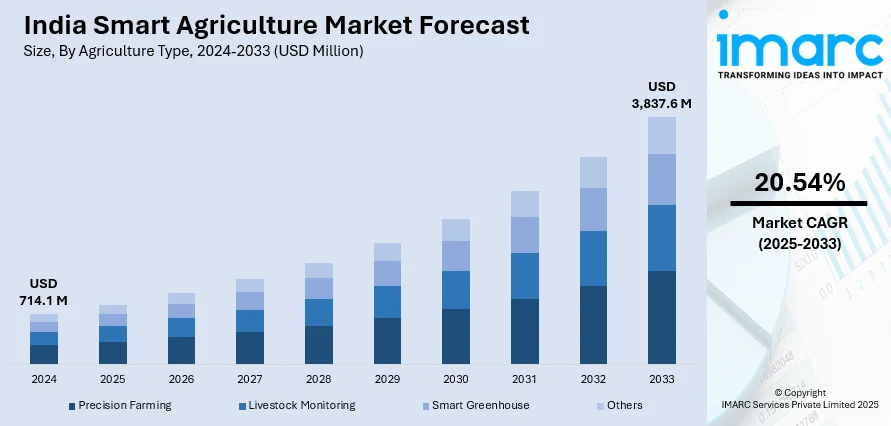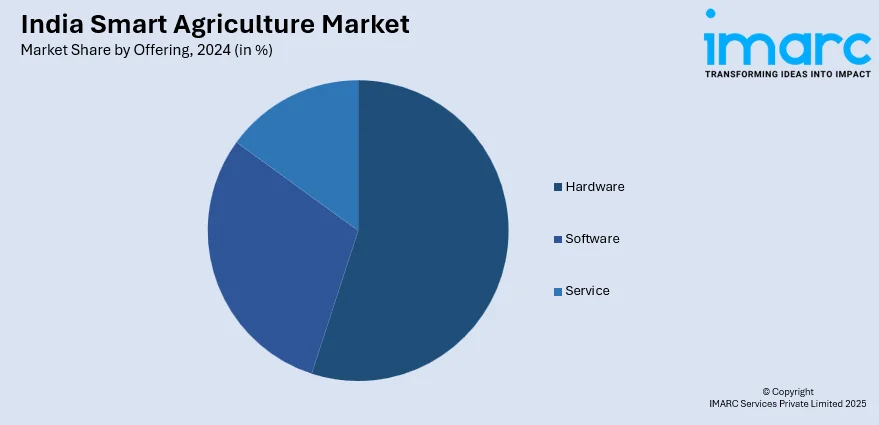
India Smart Agriculture Market Size, Share, Trends and Forecast by Agriculture Type, Offering, Farm Size, and Region, 2025-2033
Market Overview:
India smart agriculture market size reached USD 714.1 Million in 2024. Looking forward, IMARC Group expects the market to reach USD 3,837.6 Million by 2033, exhibiting a growth rate (CAGR) of 20.54% during 2025-2033. The increasing demand for precision agriculture techniques, which include precise application of water, fertilizers, and pesticides based on real-time data to help optimize resource usage, is driving the market.
|
Report Attribute
|
Key Statistics
|
|---|---|
|
Base Year
|
2024
|
|
Forecast Years
|
2025-2033
|
|
Historical Years
|
2019-2024
|
|
Market Size in 2024
|
USD 714.1 Million |
|
Market Forecast in 2033
|
USD 3,837.6 Million |
| Market Growth Rate 2025-2033 | 20.54% |
Smart agriculture, also known as precision agriculture, leverages technology to optimize farming practices and enhance overall efficiency. It integrates innovative solutions like sensors, drones, IoT devices, and data analytics to collect and analyze real-time information about crops, soil, and weather conditions. This data-driven approach enables farmers to make informed decisions, improving resource utilization, minimizing waste, and maximizing yields. Smart agriculture also facilitates remote monitoring, automated machinery, and precision application of fertilizers and pesticides. By employing smart farming techniques, farmers can achieve sustainable practices, reduce environmental impact, and adapt to changing climate conditions. Ultimately, smart agriculture aims to revolutionize traditional farming methods, promoting a more intelligent and interconnected approach to address the challenges of feeding a growing population while optimizing resource management.

To get more information on this market, Request Sample
India Smart Agriculture Market Trends:
The burgeoning smart agriculture market in India is being propelled by several key drivers. Firstly, the escalating regional population necessitates innovative approaches to meet the rising demand for food, and smart agriculture offers a solution by optimizing resource utilization and enhancing crop yields. Moreover, the increasing prevalence of climate change-induced uncertainties underscores the urgency for resilient farming practices, driving the adoption of smart technologies that enable real-time monitoring and adaptive decision-making. Furthermore, the proliferation of Internet of Things (IoT) devices and sensors has revolutionized the agriculture sector, fostering the seamless collection and analysis of data. This data-driven approach empowers farmers with actionable insights, facilitating precision farming techniques and minimizing resource wastage. In addition to this, the integration of artificial intelligence and machine learning algorithms in agriculture operations contributes to predictive analytics, enabling farmers to anticipate potential challenges and optimize crop management practices. The smart agriculture market is also fueled by the growing awareness and emphasis on sustainable farming practices. Governments and regulatory bodies are increasingly endorsing smart farming technologies to promote environmental conservation and ensure long-term agricultural viability. As a result, the convergence of technological advancements, regional demographic trends, and environmental imperatives is propelling the smart agriculture market in India to new heights, heralding a transformative era in the agriculture industry.
India Smart Agriculture Market Segmentation:
IMARC Group provides an analysis of the key trends in each segment of the market, along with forecasts at the country level for 2025-2033. Our report has categorized the market based on agriculture type, offering, and farm size.
Agriculture Type Insights:
- Precision Farming
- Livestock Monitoring
- Smart Greenhouse
- Others
The report has provided a detailed breakup and analysis of the market based on the agriculture type. This includes precision farming, livestock monitoring, smart greenhouse, and others.
Offering Insights:

- Hardware
- Software
- Service
A detailed breakup and analysis of the market based on the offering have also been provided in the report. This includes hardware, software, and service.
Farm Size Insights:
- Small
- Medium
- Large
The report has provided a detailed breakup and analysis of the market based on the farm size. This includes small, medium, and large.
Regional Insights:
- North India
- West and Central India
- South India
- East and Northeast India
The report has also provided a comprehensive analysis of all the major regional markets, which include North India, West and Central India, South India, and East and Northeast India.
Competitive Landscape:
The market research report has also provided a comprehensive analysis of the competitive landscape in the market. Competitive analysis such as market structure, key player positioning, top winning strategies, competitive dashboard, and company evaluation quadrant has been covered in the report. Also, detailed profiles of all major companies have been provided.
India Smart Agriculture Market Report Coverage:
| Report Features | Details |
|---|---|
| Base Year of the Analysis | 2024 |
| Historical Period | 2019-2024 |
| Forecast Period | 2025-2033 |
| Units | Million USD |
| Scope of the Report | Exploration of Historical Trends and Market Outlook, Industry Catalysts and Challenges, Segment-Wise Historical and Future Market Assessment:
|
| Agriculture Types Covered | Precision Farming, Livestock Monitoring, Smart Greenhouse, Others |
| Offerings Covered | Hardware, Software, Service |
| Farm Sizes Covered | Small, Medium, Large |
| Regions Covered | North India, West and Central India, South India, East and Northeast India |
| Customization Scope | 10% Free Customization |
| Post-Sale Analyst Support | 10-12 Weeks |
| Delivery Format | PDF and Excel through Email (We can also provide the editable version of the report in PPT/Word format on special request) |
Key Benefits for Stakeholders:
- IMARC’s industry report offers a comprehensive quantitative analysis of various market segments, historical and current market trends, market forecasts, and dynamics of the India smart agriculture market from 2019-2033.
- The research report provides the latest information on the market drivers, challenges, and opportunities in the India smart agriculture market.
- Porter's five forces analysis assist stakeholders in assessing the impact of new entrants, competitive rivalry, supplier power, buyer power, and the threat of substitution. It helps stakeholders to analyze the level of competition within the India smart agriculture industry and its attractiveness.
- Competitive landscape allows stakeholders to understand their competitive environment and provides an insight into the current positions of key players in the market.
Key Questions Answered in This Report
The smart agriculture market in India was valued at USD 714.1 Million in 2024.
The India smart agriculture market is projected to exhibit a CAGR of 20.54% during 2025-2033, reaching a value of USD 3,837.6 Million by 2033.
The India smart agriculture market is driven by rising demand for food security, increasing adoption of precision farming technologies, government initiatives supporting digital agriculture, and the need to optimize resource use. Additionally, growing smartphone penetration and access to real-time farm data are accelerating market adoption across rural regions.
Need more help?
- Speak to our experienced analysts for insights on the current market scenarios.
- Include additional segments and countries to customize the report as per your requirement.
- Gain an unparalleled competitive advantage in your domain by understanding how to utilize the report and positively impacting your operations and revenue.
- For further assistance, please connect with our analysts.
 Request Customization
Request Customization
 Speak to an Analyst
Speak to an Analyst
 Request Brochure
Request Brochure
 Inquire Before Buying
Inquire Before Buying




.webp)




.webp)












